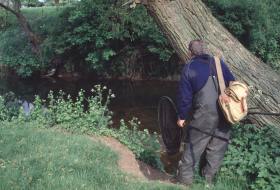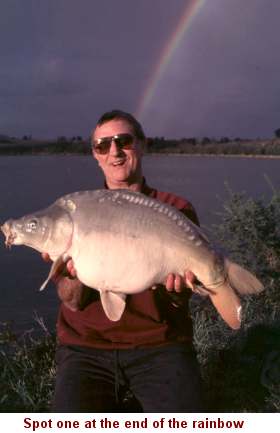An angler stands at the water’s edge, a hand held across his brow, shielding his eyes from the sun as he looks through polarizing spectacles across the expanse of seemingly featureless water.  He is looking intently at the surface for signs of fish.
He is looking intently at the surface for signs of fish.
The fish themselves could be there at the surface – leaping, rolling, splashing, swirling, tail-waving, or merely dimpling the surface. The angler, experienced as he is, knows that each of those movements tell him something about what the fish is doing, or about to do.
Leaping
Fish that jump through the surface, often completely clearing it, are almost always feeding, or about to feed, even when this happens in weak winter sunshine. These fish are using energy, and energy requires fuel, which in this case is food. Energetic leaping is almost always a sign that the fish are fit and healthy, and fit and healthy fish feed most often. Leaping carp, in particular, are feeding carp. There is always a chance the fish is leaping to clean lice off its body, but that still burns energy which needs fuel to replace it.
Rolling
Fish that are seen rolling – and bream, tench, crucian carp and barbel are specially prone to this – are also feeding, or about to feed. For years the rolling of bream was always referred to as the ‘pre-feed roll’, although we now know that bream roll during feeding too. 
Splashing
Erratic splashing at the surface is the least promising sign that fish are feeding, for it is just as likely the fish are playing, or spawning if it is the time of year for that activity. If pairs, or groups of fish, are seen splashing and cavorting together, then they are almost certainly spawning. Don’t ignore splashing fish, however, for at the very least it tells you exactly where the fish are, and that alone is worth knowing. Furthermore, any splash could be a striking pike, which is good news for the pike angler, and at least you know there must be smaller fish around for the pike to strike at.
Tail-waving
This is an absolutely sure sign that fish are feeding at that very moment. They are in shallow water ‘standing’ on their heads, feeding, tails to heaven, waving clear of the surface.
Dimpling
Those tiny circles that appear and swell at the surface are the best sign of all that fish are feeding, specially if the appearance of a dimple is accompanied by a distinct sucking sound, known by carp men as a ‘cloop’! It means the fish, most often rudd and carp, and chub on the river, are sucking insects or other edible items from the surface. 
If there are no signs of fish actually at the surface, then the angler looks for signs on the surface that tell him fish are feeding on the bottom right at that moment. These include mud clouds, bubbles, and weed movement.
Mud clouds
Mud clouds needn’t be muddy patches in otherwise clear water. Very often they are darker muddy patches in muddy water, and need a keen eye to spot them. Any area where the water is even slightly less clear than the surrounding area is worth investigating.
Bubbles
Bubbles at the surface probably cause more confusion amongst anglers than any other surface sign. Large bubbles that explode haphazardly can usually be ignored. They are simply the result of marsh gas breaking free of the bottom. 
Genuine fish-feeding bubbles are tiny, hardly more than pin-head size, formed by the marsh gas being filtered through the fish’s gill rakers. They erupt in regular patterns and in trails as the fish moves across the bottom, lingering here and there to feed. Carp and tench are especially prone to causing bubbles when feeding, and bream to a slightly lesser extent.
Weed Movement
Not a sure sign that fish are feeding; in spring to early summer the movement could be caused by spawning fish. But weed movement is always worth investigating, it could just be fish grubbing in the roots for something tasty.
But whatever the movement you see, if that movement is caused by a fish it tells you two things:
At the very least it tells you where the fish is. And if you interpret the movement correctly it can tell you how to go about catching it.










